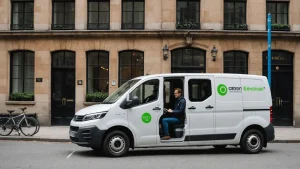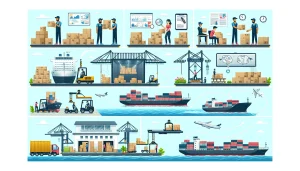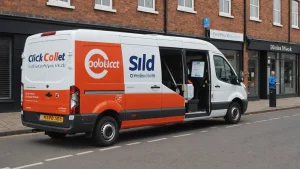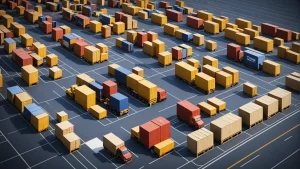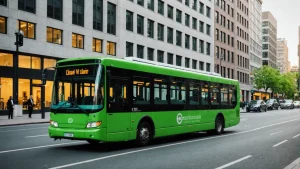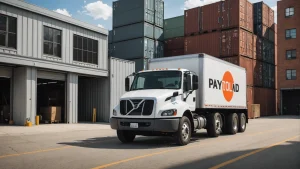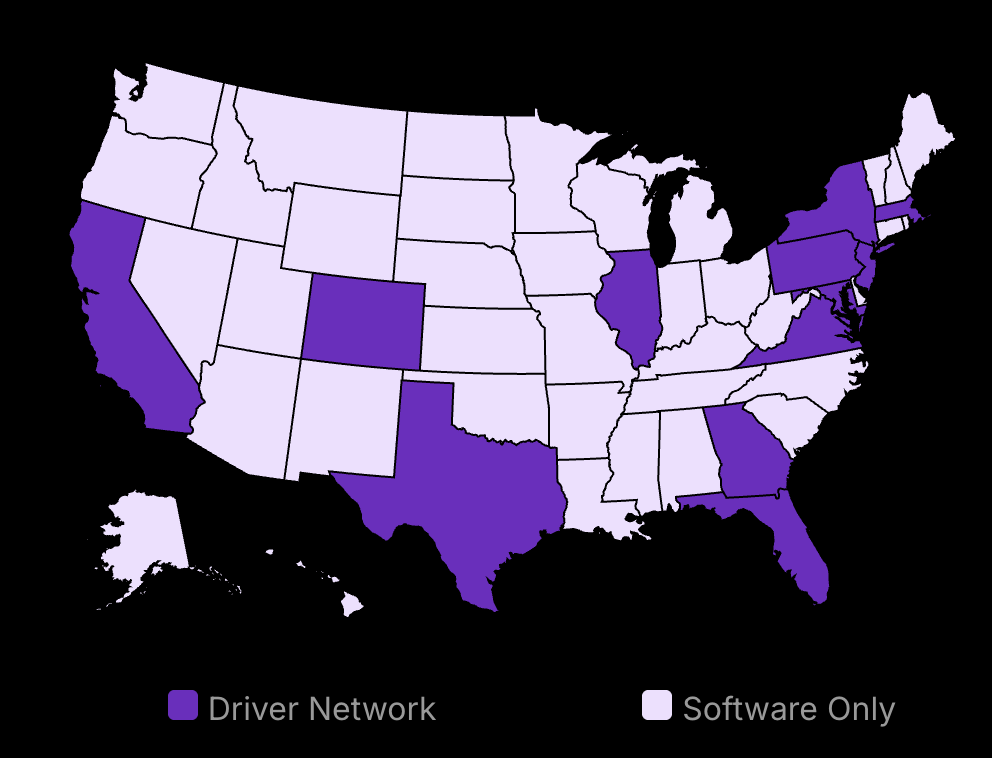What if we told you that going green could save your courier business some serious green?
In 2024, zero-emission mile delivery is no longer just a feel-good initiative – it’s a savvy business strategy that can significantly reduce your operating costs. From lower fuel expenses to reduced maintenance bills, electric vehicles are a game-changer for courier companies looking to boost their bottom line.
In this blog post, we’ll dive into how zero-emission vehicles can cut your courier costs, backed by real-world data and case studies. Get ready to crunch some numbers and discover the financial benefits of going electric in your last-mile delivery operations.

Save 80% of delivery management time
We handle everything:
- Dedicated operations manager
- Real-time tracking dashboard
- Automated customer notifications
- Urgent issue resolution
Electric Vehicle Fleet Cost Savings: How Zero Emission Vehicles Reduce Expenses
EVs significantly lower fuel and maintenance costs for last-mile delivery fleets
Battery prices have dropped 89% since 2010, making EVs more affordable than ever
Governments worldwide offer incentives and tax breaks for businesses adopting EVs
Over the past year, the adoption of electric vehicles (EVs) in last-mile delivery fleets has accelerated, driven by the potential for significant cost savings and sustainability benefits. As businesses seek to reduce expenses and reduce emissions to meet growing consumer demand for eco-friendly practices, EVs have emerged as a viable solution.
Lower Fuel Costs Drive EV Adoption
One of the most compelling reasons for businesses to switch to EVs is the potential for lower fuel costs compared to traditional gas-powered vehicles. In 2024, the average cost of electricity remains significantly lower than gasoline, making EVs more cost-effective to operate.
Reduced Maintenance Expenses
Another significant advantage of EVs is their reduced maintenance requirements compared to gas-powered vehicles. EVs have fewer moving parts, which means less wear and tear and lower maintenance costs over time.
EV components, such as electric motors and battery packs, have longer lifespans than their gas-powered counterparts. This means that businesses can save on replacement costs and keep their vehicles on the road for longer periods without interruption.
Government Incentives and Tax Breaks
Governments worldwide have recognized the importance of promoting EV adoption and have implemented various incentives. They promote tax breaks to encourage businesses to make the switch for net zero target. In 2024, many countries and local governments continue to offer these benefits, further improving the cost-effectiveness of EVs for last-mile delivery.
The specific incentives available to businesses adopting EVs vary by region and country. Some common examples include purchase rebates, tax credits, and exemptions from certain fees or taxes. Businesses need to research the incentives available in their area to maximize the cost savings potential of switching to EVs. Explore how eco-friendly logistics are revolutionizing the transportation sector in 2024, focusing on the role of electric vehicles and regional incentives.
Looking ahead, the cost savings benefits of EVs for last-mile delivery are expected to continue growing. As battery technology improves and prices decline further, the upfront cost of EVs will become even more competitive with gas-powered vehicles. Additionally, as more businesses adopt EVs and charging infrastructure expands, the convenience, energy efficiency, and practicality of operating an electric fleet will increase.
Comparing the Operating Costs of Electric vs. Gas-Powered Delivery Vehicles
Electric vehicles have significantly lower fuel costs per mile compared to gas-powered vehicles
Maintenance costs for electric vehicles are lower over the vehicle’s lifetime
Businesses that have switched to electric fleets have seen substantial cost savings
Breakdown of Fuel Costs per Mile for Electric and Gas-Powered Vehicles
One of the most significant advantages of electric vehicles (EVs) is their lower fuel costs compared to gas-powered vehicles. To understand the difference, we need to look at the cost per mile for each type of vehicle.
The cost per mile for EVs depends on the cost of electricity and the vehicle’s efficiency. On average, electricity costs about $0.12 per kilowatt-hour (kWh) in the United States, as reported by the U.S. Energy Information Administration. A typical electric delivery van consumes about 0.3 kWh per mile. This means the fuel cost per mile for an electric delivery van is approximately $0.04.
In comparison, the cost per mile for gas-powered vehicles is significantly higher. The average price of gasoline in the United States is around $3.45 per gallon, according to the U.S. Energy Information Administration (EIA). A gas-powered delivery van typically gets about 12 miles per gallon (MPG). This means the fuel cost per mile for a gas-powered delivery van is approximately $0.29.
Comparing the fuel costs per mile, electric delivery vans are about 86% cheaper to operate than gas-powered vans. For a fleet of 100 delivery vans traveling an average of 100 miles per day, switching to electric vehicles could save a company over $900,000 in fuel costs annually.
Analysis of Maintenance Costs over the Vehicle’s Lifetime
In addition to fuel cost savings, electric vehicles also have lower maintenance costs over their lifetime compared to gas-powered vehicles.
Electric vehicles have fewer moving parts than gas-powered vehicles, which means they require less maintenance. EVs don’t need oil changes, spark plug replacements, or emission checks. The primary maintenance costs for EVs are tire rotations, brake fluid changes, and coolant system flushes. Over the lifetime of an electric delivery van, maintenance costs can be up to 40% lower than a gas-powered van, as reported by the International Council on Clean Transportation.
One potential cost to consider with electric vehicles is battery replacement. However, most EV batteries are designed to last the vehicle’s lifetime. Many manufacturers offer battery warranties of 8 years or 100,000 miles. Even if a battery needs replacement, the cost has been steadily decreasing as technology improves. In 2020, the average cost of a lithium-ion battery pack dropped to $137 per kWh, a significant decrease from $1,191 per kWh in 2010, according to BloombergNEF.
Calculating the Return on Investment for Electric Vehicle Adoption
As businesses increasingly prioritize sustainability and cost-efficiency, the adoption of electric vehicles for last-mile delivery has gained significant momentum over the past year. Companies are now taking a closer look at the return on investment (ROI) associated with transitioning from gas-powered to electric delivery vehicles.
Upfront Costs vs. Long-term Savings
One of the primary considerations when calculating the ROI of electric vehicle adoption is the balance between upfront costs and long-term savings. In 2024, the initial purchase price of electric delivery vehicles remains higher than their gas-powered counterparts. However, advancements in battery technology and increased production volumes have led to a gradual decrease in the price gap. According to the International Energy Agency (IEA) Global EV Outlook, the cost of electric vehicles is expected to continue decreasing as battery costs decline and economies of scale are achieved through mass production. Additionally, BloombergNEF Electric Vehicle Outlook reports that the average battery cost per kilowatt-hour has fallen by over 80% since 2010, driving down the overall cost of electric vehicles.
Despite the higher upfront costs, electric vehicles offer significant long-term savings in terms of fuel and maintenance expenses. With electricity prices remaining relatively stable compared to the volatility of gasoline prices, businesses can better predict and control their energy costs. Additionally, electric vehicles have fewer moving parts, resulting in reduced maintenance requirements and associated costs.
Estimating the Break-even Point for Electric Vehicle Investment
To determine the financial viability of adopting electric vehicles, companies must estimate the break-even point – the time it takes for the cumulative savings to carbon offsetting the initial investment. This calculation involves several factors, including the number of vehicles in the fleet, average daily mileage, electricity rates, and maintenance costs.
Over the past year, case studies and real-world examples have emerged, providing valuable insights into the break-even point for various industries and fleet sizes. For instance, a mid-sized courier company with a fleet of 50 vehicles and an average daily mileage of 100 miles per vehicle could potentially reach the break-even point within 3-5 years, depending on local energy rates and incentives.
Several factors can influence the break-even point for electric vehicle adoption:
Fleet size and composition
Average daily mileage
Electricity rates and charging infrastructure costs
Government incentives and tax credits
Vehicle maintenance and depreciation
As businesses navigate the transition to electric vehicles, it’s crucial to consider these factors and adapt the break-even point calculation to their specific circumstances.
Tools and Resources for Assessing the Financial Viability of Electric Fleets
To assist companies in evaluating the financial feasibility of electric vehicle adoption, various tools and resources have emerged over the past year. These include:
Electric vehicle total cost of ownership (TCO) calculators
Fleet management software with electric vehicle integration
Government and industry reports on electric vehicle adoption trends and best practices
By leveraging these tools and resources, businesses can make informed decisions about the timing and scale of their electric vehicle adoption plans. As more companies share their experiences and best practices, the collective knowledge base continues to grow, paving the way for a more widespread transition to sustainable last-mile delivery.
Looking ahead, the next 12 months are expected to bring further advancements in electric vehicle technology, infrastructure, and financial incentives. As battery prices continue to decline and charging networks expand, the ROI for electric vehicle adoption will become increasingly attractive. Companies that proactively assess their fleet’s potential for electrification and develop strategic transition plans will be well-positioned to reap the benefits of reduced operating costs and enhanced sustainability in the years to come.
Optimizing Delivery Routes for Efficiency: Maximizing the Benefits of Zero Emission Vehicles
Route optimization software can reduce travel distance by up to 20%
Real-time traffic data helps avoid delays, saving 10-15% in delivery times
Analyzing historical data uncovers patterns for more efficient route planning
Implementing route optimization software is a critical step in maximizing the benefits of zero-emission vehicles in last-mile delivery. By leveraging advanced algorithms and machine learning techniques, these tools can analyze vast amounts of data to determine the most efficient routes for each delivery, taking into account factors such as traffic patterns, road closures, and customer preferences.
Reducing Travel Distance and Fuel Consumption
One of the primary advantages of route optimization software is its ability to minimize the total distance traveled by delivery vehicles. Studies have shown that these tools can reduce travel distance by up to 20%, significantly cutting fuel costs and reducing the environmental impact of last-mile delivery.
Leveraging Real-Time Traffic Data
Incorporating real-time traffic data into route optimization software can further enhance its effectiveness. By continuously monitoring traffic conditions and adjusting routes accordingly, delivery vehicles can avoid congestion and delays, saving valuable time and reducing fuel consumption.
Analyzing Historical Delivery Data
In addition to real-time data, analyzing historical delivery data can provide valuable insights for route optimization. By identifying patterns in customer preferences, delivery times, and traffic conditions, last-mile delivery providers can make data-driven decisions to improve efficiency and reduce costs.
For example, Amazon uses machine learning algorithms to analyze historical data and predict demand for specific products in different areas. This allows the company to strategically pre-position inventory closer to customers, reducing delivery times and costs. By applying similar techniques to route optimization, last-mile delivery providers can uncover opportunities for improvement and maximize the benefits of their zero-emission vehicle fleets.
Best Practices for Route Optimization in Last Mile Delivery
Route optimization is a critical aspect of last-mile delivery, especially when using zero-emission vehicles. By carefully planning routes, companies can maximize the efficiency of their delivery operations while minimizing costs and environmental impact.
Factors to Consider When Planning Delivery Routes
When planning delivery routes for zero-emission vehicles, several key factors must be taken into account:
Vehicle Range
The range of electric vehicles can vary significantly depending on the model and battery capacity. It’s essential to choose vehicles with sufficient range to cover the planned delivery routes without requiring frequent recharging.
Charging Infrastructure
The availability and location of charging stations is another crucial consideration. Delivery routes should be planned to ensure vehicles can access charging points when needed, without causing significant delays or detours.
Companies should also consider investing in their charging infrastructure at delivery hubs or key locations along routes. This can provide greater control and reliability compared to relying solely on public charging networks. According to the International Council on Clean Transportation, the number of public charging points in the United States increased by 15% between 2020 and 2021, reaching over 20,000 stations.
Traffic Patterns and Congestion
Real-time traffic data should be incorporated into route planning to avoid congested areas and minimize delivery times. Advanced routing software can analyze historical traffic patterns and predict congestion, allowing routes to be optimized accordingly. For instance, Google Maps uses real-time traffic data to provide the most efficient routes, reducing travel time by up to 25%.
Strategies for Balancing Delivery Speed and Efficiency
While speedy deliveries are important for customer satisfaction, it’s equally crucial to balance speed with efficiency. Rushing deliveries can lead to higher energy consumption, increased costs, and potentially more vehicle wear and tear.
To strike the right balance, companies can leverage advanced algorithms and machine learning techniques. These tools can analyze vast amounts of data, including customer locations, order volumes, vehicle capacities, and traffic conditions, to create optimized delivery routes that minimize distance traveled and time spent on the road.
Dynamic routing is another powerful strategy. Rather than planning fixed routes, dynamic routing allows routes to be adjusted in real time based on changing conditions such as new orders, cancellations, or traffic incidents. This flexibility helps ensure that vehicles are always taking the most efficient path.
Government Incentives for Green Logistics: Taking Advantage of Financial Support
Federal and state governments offer various incentives for businesses adopting electric vehicles
Tax credits and grants can significantly reduce the cost of transitioning to a zero-emission fleet
Learning how to navigate the application process is crucial for maximizing financial support
Overview of Federal and State Incentives for Electric Vehicle Adoption
The United States federal government, along with many state governments, has recognized the importance of transitioning to cleaner transportation methods for emission reductions. To encourage businesses to adopt electric vehicles (EVs) for their fleets, a range of incentives are available at both the federal and state levels.
At the federal level, the Qualified Plug-In Electric Drive Motor Vehicle Credit provides a tax credit of up to $7,500 for the purchase of a new EV. This credit applies to both personal and business vehicles, making it an attractive option for companies looking to green their fleets.
In addition to federal incentives, many states offer their programs to support EV adoption. For example, California’s Hybrid and Zero-Emission Truck and Bus Voucher Incentive Project (HVIP) provides vouchers to help offset the cost of purchasing electric trucks and buses. Other states, such as New York and Massachusetts, offer rebates and grants for businesses investing in EV charging infrastructure. By net zero targets, governments try to make our world greener.
How to Navigate the Application Process for Government Incentives
To take advantage of the various government incentives available for green logistics, businesses must navigate the application process for each program. While the process can vary depending on the specific incentive, there are some general steps companies can follow to ensure a smooth application experience.
Start by researching the federal and state incentives available for your specific location and vehicle types. The U.S. Department of Energy’s Alternative Fuels Data Center provides a comprehensive database of federal and state laws and incentives related to alternative fuels and vehicles.
Once you have identified the incentives you want to pursue, gather all the necessary documentation. This may include proof of vehicle purchase, vehicle specifications, and business information. Having these documents readily available will streamline the application process.
Carefully fill out and submit applications for each incentive program, ensuring that all required information is provided. Keep track of application deadlines and follow up with the appropriate agencies if needed. Once your applications are approved, work with your finance team to ensure that the tax credits or grants are properly applied to your business accounts.
By understanding the available government incentives and successfully navigating the application process, businesses can significantly reduce the costs associated with transitioning to a zero-emission last-mile delivery fleet. This financial support, combined with the long-term savings from reduced fuel and maintenance costs, makes investing in green logistics an increasingly attractive option for companies looking to cut costs and reduce their environmental impact.
Exploring the Benefits of Government Incentives for Last Mile Delivery
Government incentives can significantly reduce the upfront costs of adopting electric vehicles for last-mile delivery
Businesses that have leveraged these incentives have seen substantial long-term savings and improved sustainability
Developing a strategic plan is crucial for maximizing the value of incentives and ensuring a successful transition to zero-emission fleets
Quantifying the Financial Impact of Incentives on Electric Vehicle Adoption
Government incentives, such as tax credits, grants, and subsidies, play a crucial role in encouraging businesses to adopt electric vehicles (EVs) for last-mile delivery. These incentives can significantly reduce the upfront costs associated with purchasing EVs, making the transition more financially viable for companies of all sizes.
Beyond the upfront savings provided by government incentives, electric vehicles offer significant long-term cost benefits compared to traditional internal combustion engine (ICE) vehicles. EVs have lower fuel and maintenance costs, as they are more energy-efficient and have fewer moving parts that require regular servicing.
Strategies for Maximizing the Value of Incentives in the Long-Term
To fully capitalize on the benefits of government incentives for electric vehicle adoption, businesses must develop strategic plans that consider both the short-term and long-term implications of transitioning to achieve net zero-emissions fleet.
Before investing in electric vehicles, companies should conduct a thorough cost-benefit analysis that takes into account the available incentives, upfront costs, long-term savings, and operational requirements. This analysis should consider factors such as the fleet size, average daily mileage, and the availability of charging infrastructure.
By carefully evaluating the financial impact of transitioning to EVs, businesses can make informed decisions and develop a roadmap for successful adoption.
To ensure a smooth transition to electric vehicles, companies must invest in the necessary charging infrastructure and employee training. This may involve installing on-site charging stations, partnering with local charging networks, and providing training to drivers and maintenance staff on the proper care and operation of EVs.
By proactively addressing these infrastructure and training needs, businesses can minimize downtime, optimize vehicle performance, and maximize the near-term and long-term value of their EV investment.
Government incentive programs for electric vehicles are subject to change over time, as priorities and budgets shift. To maximize the benefits of these incentives, businesses must stay informed about any updates or changes to the programs they are utilizing.
This may involve regularly reviewing government websites, attending industry events, and engaging with local representatives to stay abreast of any developments that could impact the company’s EV strategy. By staying adaptable and responsive to changes in incentive programs, businesses can ensure they are always positioned to take full advantage of the available financial support.
Reduced Fuel and Maintenance Expenses: The Financial Advantages of Zero Emission Vehicles
Electric vehicles (EVs) offer lower cost per mile than gas-powered vehicles
Stable electricity prices shield delivery fleets from fuel price volatility
EVs require less maintenance, resulting in additional cost savings
Analyzing the impact of fuel price volatility on delivery fleet expenses
Fuel price volatility can significantly impact the operating costs of last-mile delivery fleets. Gas prices are subject to fluctuations due to various geopolitical and economic factors, making budgeting and forecasting challenging for delivery companies.
In contrast, electricity prices tend to be more stable. This stability in the energy sector allows companies to accurately predict and manage their energy costs, reducing financial risks associated with fuel price volatility.
Exploring the savings potential of reduced maintenance costs
EVs have fewer moving parts than gas-powered vehicles, which translates to lower maintenance costs. The simplicity of EV powertrains eliminates the need for regular oil changes, spark plug replacements, and other engine-related maintenance tasks.
Quantifying the Cost Savings of Electric Vehicle Adoption in Last Mile Delivery
Electric vehicles offer significant fuel and maintenance savings compared to gas-powered fleets
Long-term cost projections show substantial savings over the lifespan of electric vehicles
Real-world examples demonstrate the financial benefits of electric vehicle adoption in last-mile delivery
As businesses increasingly prioritize sustainability and cost-efficiency, the adoption of electric vehicles in last-mile delivery has become a game-changer for emissions reductions. By quantifying the cost savings associated with this transition, logistics companies can make informed decisions about their fleet management strategies.
Breakdown of Fuel and Maintenance Expenses for Electric vs. Gas-Powered Fleets
One of the most significant advantages of electric vehicles is their lower fuel costs compared to traditional gas-powered vehicles. According to a study by the U.S. Department of Energy, the cost of electricity per mile traveled is approximately 50% lower than the cost of gasoline (DOE, 2021). This means that companies can significantly reduce their fuel expenses by switching to electric vehicles for last mile last-mile
In addition to lower fuel costs, electric vehicles also require less maintenance compared to their gas-powered counterparts. Electric motors have fewer moving parts, which means they are less prone to wear and tear. This translates to reduced maintenance costs over the life of the vehicle. A study by Consumer Reports found that electric vehicle owners spend about half as much on maintenance and repair as owners of gas-powered vehicles (Consumer Reports, 2020).
Long-Term Cost Projections Based on Vehicle Lifespan and Replacement Cycles
When evaluating the cost savings of electric vehicle adoption, it’s essential to consider the long-term financial implications. Electric vehicles typically have a longer lifespan than gas-powered vehicles, which means companies can save on replacement costs over time.
The Importance of Last Mile Delivery in Logistics: Understanding the Impact on Customer Satisfaction
Last-mile is the final step in the logistics process, directly impacting customer experience
Delivery speed, accuracy, and consistency are key factors in building customer loyalty
Optimizing last-mile can lead to increased customer satisfaction and business growth
Defining Last-Mile Delivery and Its Role in the Overall Logistics Process
Last-mile refers to the final leg of the logistics process, where a product is transported from a distribution center or warehouse to the end customer’s doorstep. This crucial step is often the most complex and expensive part of the supply chain, as it involves navigating through urban areas, dealing with traffic congestion, and ensuring timely delivery to individual customers.
Despite its challenges, the last mile plays a vital role in the overall logistics process. It is the point at which a business directly interacts with its customers, making it a critical touchpoint for building brand reputation and customer loyalty. A smooth and efficient last-mile process can differentiate a company from its competitors and contribute to long-term success.
Exploring the Relationship Between Last-Mile Delivery and Customer Experience
In today’s fast-paced, e-commerce-driven world, customer expectations for delivery services have never been higher. A study by PWC found that 41% of consumers are willing to pay more for same-day delivery, highlighting the importance of speed in the last-mile process.
However, speed is not the only factor that influences customer experience. Accuracy and consistency are equally important. Customers expect their orders to arrive undamaged and complete, with no missing items or incorrect products. They also appreciate consistent delivery times and the ability to track their orders in real time.
To meet these expectations, businesses are turning to advanced technologies such as route optimization software, real-time tracking systems, and automated delivery notifications. These tools help streamline the last-mile delivery process, reduce errors, and improve communication with customers.
For example, route optimization software can help courier companies plan the most efficient delivery routes, taking into account factors such as traffic patterns, road closures, and customer preferences. This not only saves time and reduces fuel costs but also ensures that customers receive their orders promptly.
Analyzing the Impact of Delivery Speed, Accuracy, and Consistency on Customer Loyalty
A positive last-mile delivery experience can have a significant impact on customer loyalty and repeat business. According to a survey by Convey, 84% of consumers say that they are unlikely to shop with a retailer again after just one poor delivery experience.
On the other hand, consistently meeting or exceeding customer expectations can lead to increased loyalty and advocacy. A study by Dropoff found that 97% of consumers are more likely to recommend a business to others if they have a positive delivery experience.
The consequences of poor last-mile delivery extend beyond lost customers and revenue. Businesses may also face additional costs related to returns, refunds, and customer service inquiries. In some cases, negative reviews and word-of-mouth can damage a company’s reputation and make it more difficult to acquire new customers.
Addressing the Challenges of Last Mile Delivery: How Zero Emission Vehicles Offer Solutions
Zero-emission vehicles can solve common last-mile delivery problems like traffic congestion and parking limitations
Electric vehicles improve efficiency and flexibility in last-mile logistics
Adopting zero-emission vehicles reduces the environmental impact of last-mile delivery
Identifying Common Problems in Last Mile Delivery
Last-mile delivery, the final step in getting products to customers’ doorsteps, faces several challenges that can hinder efficiency and customer satisfaction. Traffic congestion in urban areas is a major hurdle, causing delays and increasing delivery times.
Another common issue is the lack of available parking spaces for delivery vehicles. A survey by the National Association of City Transportation Officials found that commercial vehicles spend an average of 28% of their time searching for parking. This not only delays deliveries but also contributes to traffic congestion, air pollution, and increased emissions from idling vehicles.
Exploring How Electric Vehicles Can Mitigate These Challenges
Zero-emission vehicles, particularly electric vehicles (EVs), offer solutions to the problems plaguing last-mile delivery. EVs have several advantages over traditional gas-powered vehicles that can improve efficiency and flexibility in last-mile logistics.
Electric vehicles have a lower cost per mile compared to gas-powered vehicles, thanks to the lower cost of electricity and reduced maintenance requirements. According to a report by the U.S. Department of Energy, the cost of electricity for an EV is about half the cost of gasoline on a per-mile basis. This cost savings can be significant for last-mile delivery fleets that cover many miles each day.
EVs also can regenerate energy during braking, which can extend their range and further improve efficiency. This regenerative braking feature is particularly useful in urban environments with frequent stops and starts.
Discussing the Potential for Zero-Emission Vehicles to Reduce Environmental Impact
In addition to improving efficiency and flexibility, zero-emission vehicles can significantly reduce the environmental impact of last-mile delivery. Transportation is a major contributor to greenhouse gas emissions, with light-duty vehicles (including delivery vans) accounting for 59% of transportation-related emissions in the US.
By adopting zero-emission vehicles, last-mile delivery companies can reduce their carbon footprint and contribute to their efforts in tackling climate change to limit global warming. This not only benefits the environment but also aligns with the growing consumer demand for sustainable and eco-friendly products and services.
Many cities and countries have set ambitious targets for reducing greenhouse gases and improving air quality. For example, California has set a goal of achieving carbon dioxide and neutrality by 2045, which will require a significant shift towards zero-emission vehicles across all sectors, including last-mile delivery.
By reducing emissions and investing in zero-emission vehicle fleets, last-mile delivery companies can position themselves as leaders in sustainability and contribute to the achievement of these important public health and environmental goals.
The Future of Last Mile Delivery: Predictions and Trends Of Greenhouse Gas Emissions for 2024 and Beyond
Electric vehicle adoption in last-mile delivery is set to soar
Autonomous vehicles and drones will revolutionize the industry
Government regulations and incentives will drive green logistics forward
Forecasting the growth of electric vehicle adoption in last-mile delivery
The past 12 months have seen a significant uptick in the adoption of electric vehicles (EVs) for last-mile delivery. In January 2024, major courier companies announced plans to electrify their fleets, with some setting ambitious targets of 50% EV adoption by 2030. This trend continued throughout the year, with smaller delivery companies following suit and investing in electric vans and trucks.
Analyzing the potential impact of emerging technologies (e.g., autonomous vehicles, drones) on the industry
While EVs have dominated the last-mile delivery landscape in 2024, other emerging technologies are poised to make a significant impact in the coming years. Autonomous vehicles (AVs) and drones have been the subject of extensive testing and pilot programs throughout the past 12 months.
Exploring the role of government regulations and incentives in shaping the future of green logistics
Government policies have played a crucial role in shaping the future of last-mile delivery in 2024. Throughout the year, various countries and cities have introduced regulations and incentives aimed at promoting the adoption of zero-emission vehicles and sustainable logistics practices.
Embracing Net Zero Emissions in Last Mile Delivery: The Smart Choice for Couriers in 2024
Electric vehicles offer significant cost savings for last-mile delivery, reducing fuel expenses and maintenance costs while having net zero emissions and providing long-term financial benefits. By comparing the operating costs of electric and gas-powered vehicles, businesses can make informed decisions about transitioning to zero-emission fleets. Interested in reducing your carbon footprint? Discover strategies for adopting eco-friendly delivery methods to improve your bottom line.
Optimizing delivery routes and leveraging government incentives further enhance the financial viability of electric vehicle adoption. As the logistics industry evolves, embracing zero-emission vehicles not only cuts costs but also improves customer satisfaction by addressing common last-mile delivery challenges.
Are you ready to leap more sustainable and cost-effective last-mile delivery solution? Start by assessing your fleet’s specific needs and exploring the available electric vehicle options. Reach out to our team of experts for personalized guidance on making the switch to zero-emission vehicles and revolutionizing your last-mile delivery operations.






